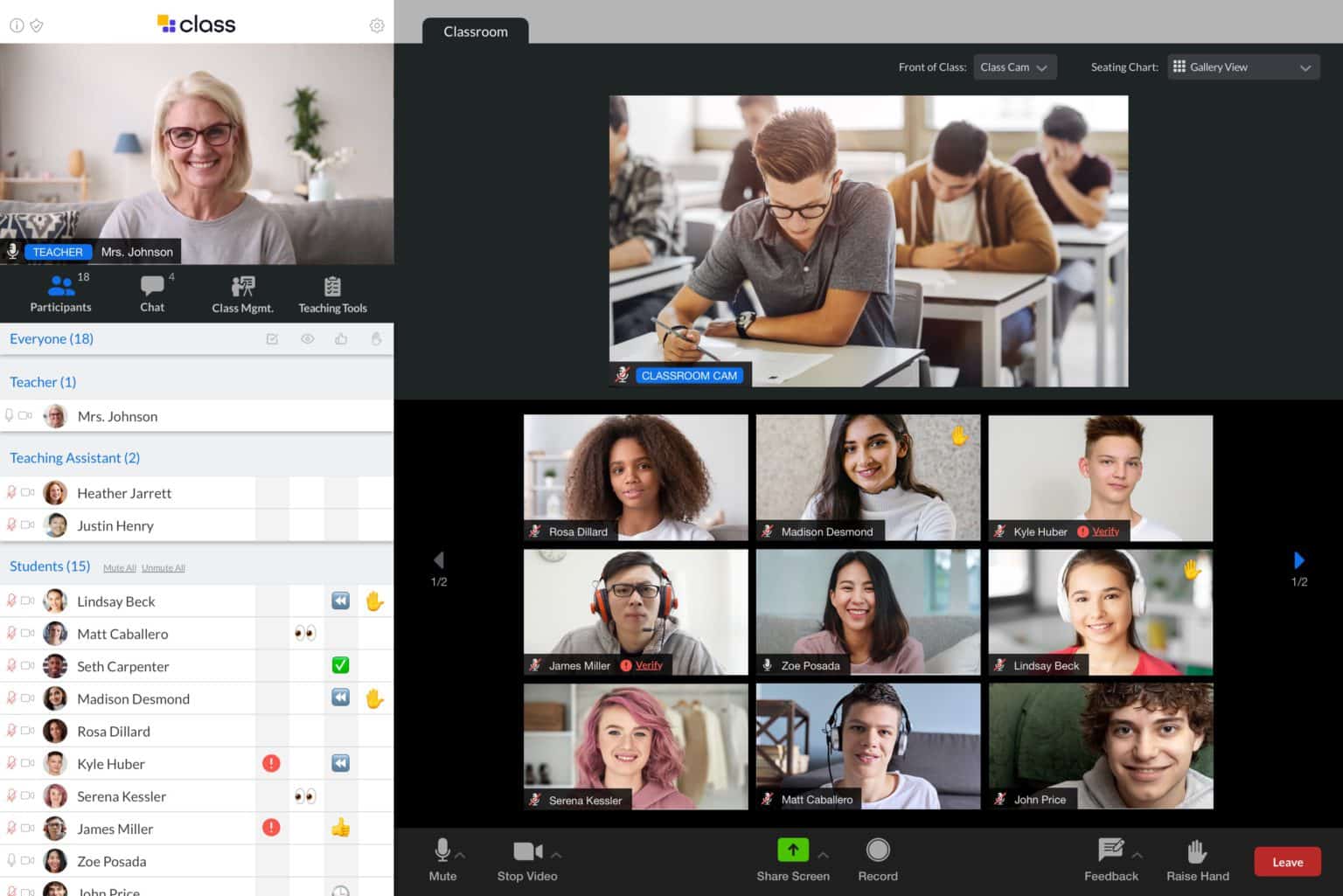
Jason Bedford is the SVP of Education at Class, and is a passionate educator and technologist. Having held executive positions with leading EdTech companies, he's worked hard to drive innovation with global educational partners and support their mission of equity and student achievement. Before EdTech, he was an educator in Wake County Public Schools.

Jason Bedford is the SVP of Education at Class, and is a passionate educator and technologist. Having held executive positions with leading EdTech companies, he's worked hard to drive innovation with global educational partners and support their mission of equity and student achievement. Before EdTech, he was an educator in Wake County Public Schools.

Almost every student and teacher in North America has now experienced virtual learning. Two years ago, teachers and students at all levels of education were immediately and massively impacted by the need to shift to virtual learning environments during the pandemic. Despite the fact that most thought the transition would be a temporary one, many are still operating in some virtual or hybrid fashion—or are evaluating the opportunities for redesign that a hybrid future affords learners, families, and teachers.
There have certainly been some bumps along the way, and a steep learning curve for many. These experiences have been a catalyst for innovation and hopeful prospects for what the future of education will look like.
As administrators, teachers, students, and parents have grappled with virtual learning, their lived experiences—good and bad—are paving the way for change and innovation. Frustrations and failures for many sit in contrast with novel approaches that suggest new possibilities for the future.
When forced to change, and change quickly, the momentum and personal victories have revealed new possibilities for moving forward. Virtual learning offers big benefits like flexibility, the opportunity to reach and engage with others—both teachers and students—without regard to geography, and the ability to flexibly adapt to situations. I see innovation in models that allow us to adapt to challenges and opportunities.
The top 6 for K-12 in 2022 and beyond are:
Leaders and teachers who recognize that the school calendar and fixed times of access to formal educational supports do not meet the needs of all learners / families in their community.
Leaders and teachers who recognize that the geographic boundaries of our school or system are imposing limitations on students we could serve well or increasing burden on existing learners
Leaders and teachers who recognize that in their community of learners, the pace of curriculum delivery and addressing the standards limits our ability to personalize or collaborate…limits our ability to address gaps and provide enrichment opps.
Leaders who recognize that teachers, para-pro, instructional coaches, and tutors want professional options, career paths that require more flexibility of schedule and location. Recruitment and retention will require a shift in our practices.
Leaders and teachers who recognize that the current systems of education have historically marginalized groups of students. Trying to redesign a different future with the constraints of 8~3 and in brick and mortar locations introduces the same impediments and limits possibilities.
Leaders who recognize that there are consistent budget pressures and increasing costs. Identifying ways to serve students and families well will require a fresh perspective on how we allocate resources around the student.
The education sector has historically been considered a slow-moving industry with few changes over the past several decades. Today, though, fueled by a large-scale “experiment from necessity” in public education has demonstrated that pivots don’t have to be minuscule. We can do big things. The connections between school and home can be made more robust through digital mediums when designed thoughtfully and leveraging technology that focuses on the interactions of peer to peer and teacher to student.
Systems work to dismantle racism in our nation’s schools and make changes to remove inequities have been center-stage for many years. Again, though, the pace of change has been slow. It is time for that to change.
The traditional learning model that was so entrenched for decades was hard to shift away from. Looking only through the lens of schooling that we know from past experiences limited the possibilities for leaders to take on the work of systems change and to make meaningful progress. Today, though, almost every district in North America has adopted responsive practices to ever-changing information.
As we move forward, it will be critical to use data to target resources where needs are most acute. Systems change and equity work require new options that allow for increased flexibility in place, time, and path. Infusing virtual options will continue to be a catalyst for redesign possibilities. Despite all we’ve learned and all we’ve adjusted over the past several months, there are likely still new opportunities to be discovered to ensure that we are addressing the needs of all learners in ways we couldn’t in the past.
Systems change work requires us to involve the stakeholders that the system has historically marginalized and bring them into our planning and designs. In the process of moving from design to implementation, we will need to be continually alert to teacher and leadership fatigue or resistance and be thoughtful about change management and lead with our “why”.
Teachers, coaches, counselors, and leaders are wary. The amount of change, the level of expectations, and the growing scope of educators’ roles have been exhausting and create conditions that will require immediate change.
Even pre-pandemic, recruitment and retention was top-of-mind in education; these needs have accelerated during the pandemic at an unanticipated rate. Changes are needed.
Traditional methods of small annual pay bumps and pensions’ golden handcuffs are no longer enough to keep teachers in the profession. Higher education institutions are seeing record low enrollments in teacher prep programs, and lateral entry licensure remains restrictive.
Public/private partnerships can be forged that allow those in the workforce to teach a class and teachers to rotate into companies that provide instructional coaching, while developing a future workforce that is learning content, building skills, and understanding the application of knowledge in the real world. States, providences, and districts will continue to evaluate these and other shared resource models as they seek new alternatives for addressing ongoing staffing issues while ensuring the effective delivery of public education.
Deviation from our norms of hiring, compensating, career pathing, and assigning responsibilities is not going to be easy. Consider smaller steps like disaggregating the roles of a teacher, distributing expertise, and wrap around services that support the students. Some tasks like lesson design, grading, small group instruction can be distributed differently. One teacher doing all the roles is not always the best approach.

Spending on educational technology has exploded and we have seen a proliferation of tools to aid online teaching and learning. Priorities are now shifting to integrating devices and technology to enable interoperability and provide better user experiences.
To help users and potential users stay on top of trends, new releases, and use cases, fan-favorite tools will need to be organized for users. Thoughtful district and technology leaders understand that the pandemic-inspired investments have had spotty adoption and recognize that these tools live both in- and outside of their security firewalls. It’s also difficult to measure the impact of these tools in many cases.
We expect a market shift that will, ultimately, lead to the identification of a few core platforms that will be foundational for education at all levels.
The National Education Policy Center (NEPC) has been a 10-year critic of virtual education. In May 2021, though, they released a report on Virtual Schools in the US 2021 that showcases a significant shift in policy and funding, increases in enrollment, and stunning (to some) outcomes from online schools compared to traditional schools. Florida online schools, for instance, have outpaced districts for “A” ratings. In the report, NEPC also continued to cite concerns about a lot of research related to instructional practices to help credibly guide future policy decisions.
For fiscal year 2021, 18 legislative bills were passed by states wishing to improve access to virtual education, and to increase choice beyond for-profit providers while not imparting financial limitations or restrictions. Discussions related to online learning are ongoing and growing. In fact, 43,000 news articles cited online learning in K12 in 2021. Despite a return to in-person learning in many school districts, online learning remains a topic that has taken center stage and will likely be there for some time even as in-person learning returns full force.
As we move forward, policymakers and influencers will need more credible research. Funding formulas may change. As we learn more, know more, and the population of students served by virtual or blended experiences grows, we can expect to see continued House and Senate bill activity that will shift the landscape.
Over the past 24 months, unprecedented federal funding and stimulus have been poured into education. But we’ve reached a spending peak, and districts will need to look for ways to streamline spending. Financial buyers will increasingly demand that ROI can be proved and greater efficiencies can be gained.
Whole child social, emotional, and mental health were priorities prior to the pandemic, but have really become an area of heightened concern over the past several months. This is a priority across all learning communities. Here, again, technology can prove valuable in helping to facilitate connections, provide access to clinical support and distribute resources. Virtual models allow for scale and a broader reach of services while increasing access and flexibility.
Of course, creating deep human connections requires intentionality and time. Because of their time with students and the relational aspects of their work, teachers are uniquely situated to monitor and support students. Adults will also need support, so we need to look for and foster environments to serve adults in our systems as well.
While virtual experiences have been mixed during the pandemic, there clearly are a variety of ways that technology will continue to impact the delivery of education and support both the educational and emotional needs of students, teachers, administrators, and parents. Understanding the forces that both help and hinder online learning is an important first step to overcome obstacles and leverage opportunities as we move forward.

Jason Bedford is the SVP of Education at Class, and is a passionate educator and technologist. Having held executive positions with leading EdTech companies, he's worked hard to drive innovation with global educational partners and support their mission of equity and student achievement. Before EdTech, he was an educator in Wake County Public Schools.

Jason Bedford is the SVP of Education at Class, and is a passionate educator and technologist. Having held executive positions with leading EdTech companies, he's worked hard to drive innovation with global educational partners and support their mission of equity and student achievement. Before EdTech, he was an educator in Wake County Public Schools.
Get our insights, tips, and best practices delivered to your inbox

Sign up for a product demo today to learn how Class’s virtual classroom powers digital transformation at your organization.

Features
Platforms
Integrations
Additional Products